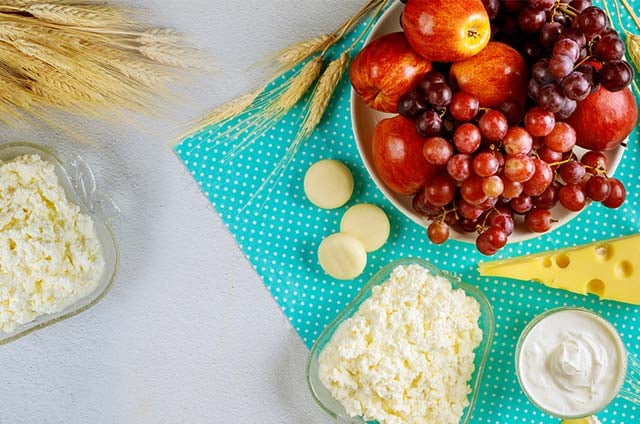
Functional foods—those that offer health benefits beyond nutrition—were on the rise before COVID-19 arrived. But with the pandemic causing many people to become hyper-focused on their health and well-being, the trend has picked up steam.
“We anticipate continued growth in functional foods, especially coming out of the global health pandemic,” says Shelley Balanko, Ph.D., a senior vice president at The Hartman Group. More consumers “have embraced the food-is-medicine philosophy” over the last 12 months, she adds, and are prioritizing things like weight management and gut health, which can strengthen immune systems.
Recent research from Symrise confirms that nearly 4 in 10 (37%) U.S. consumers are seeking functional benefits from their food and drinks—a 23% increase since 2019. The flavor development company also projects that the global functional foods market will reach $275 billion by 2025.
Dairy foods—everything from milk and cream to cheese and yogurt—are considered functional foods because of the nutrients they contain. They’re also among the best-known and most commonly consumed functional foods on the market. Foodservice operators can capitalize on consumers’ growing interest in these foods in new dishes, through often simple ingredient swaps in existing offerings, and by updating their menu descriptions to reflect these inclusions.
What Are Functional Foods?
Happily for operators, the functional foods category is broad.
Foods rich in fiber, fatty acids, bacterial cultures, probiotics, and flavonoids—think fish, whole grains, beans, berries and low-fat dairy products—“provide health benefits beyond fundamental nutrition and may help in reducing disease risk,” says Kristal Shelden, MPH, RDN, project manager of nutrition science for the Dairy Council of California. In addition to specific nutrients like Vitamins A and D, these foods feature physical and chemical properties that contribute to overall health and wellness—what’s known within the nutritional community as the “dairy matrix.”
Take cultured dairy foods like cottage cheese, sour cream and soft cheeses such as blue cheese, for example. Such products “contain live microbes and cultures, peptides, and short-chain fatty acids that interact with vitamins, minerals, and other nutrients to enhance health effects,” Shelden explains. There’s a growing body of evidence that diet influences the gut’s microbiome, she adds, which in turn impacts metabolism and immunity—“ultimately affecting health and risk for chronic diseases.” Dairy consumption, when part of a healthy diet, also has been linked to a wide range of health benefits, including blood pressure control, bone health, and reduced risks of Type-2 diabetes and heart disease.
Beyond Comfort Food
So where does all this leave operators looking to connect with wellness-minded consumers as they return to restaurants in droves?
For starters, keep in mind that people are ready to go beyond the comfort foods they might have turned to at the height of the crisis. “There’s going to be more interest in ingredients and preparation that reflect fresh offerings,” Balanko says, noting that many people gained weight during the pandemic.
She also suggests operators remain mindful of the fact that consumers keyed into functional foods generally prefer the “inherent functionality” of minimally processed whole foods rather than products fortified with nutrients to add functionality. (Functional foods also can refer to products with added nutrients and vitamins, such as whole grain pasta with added omega-3 fatty acids, or beverages with added antioxidants.)
The safer move with menu offerings is to focus on naturally occurring functional ingredients, Balanko says. Her company expects to see more fresh-style cheese—think feta and even cottage cheese—in protein-forward salads. Balanko also points to cultured dairy products as foods many consumers now associate with immunity support via healthy digestion. “Consumers are getting that digestion is the root of all wellness,” she notes.
Other industry experts also see untapped cooking potential in cultured foods. “The beauty of foods like yogurt and cottage cheese is in their duality as a nutritious food and a culinary canvas,” says Sally Cummins, RDN, LDN, vice president of nutrition science and partnerships at the National Dairy Council. Both foods lend themselves to savory, sweet or neutral flavor profiles and can add texture, creaminess, and body to recipes, she adds.
Cummins suggests revamping aioli with yogurt instead of mayo or making yogurt cheese, known as labneh—“a popular favorite in many Mediterranean countries,” she says. Or consider using cottage cheese to add fluffiness and functionality to pancakes, egg muffins, egg casseroles, and pasta dishes like mac and cheese or lasagna. Cottage cheese, she notes, has emerged as a trending substitution for—or addition to—a beloved breakfast favorite: “Move over avocado toast; try cottage cheese toast,” she says.
Things to Remember
Consumers’ understanding of functional foods and interest in them is sure to keep evolving. Keep these general points in mind when considering how to evolve your menu and communicate the health benefits of dairy to guests.
Focus on digestive health and energy-sustaining attributes: People are interested in these things, so operators should feel comfortable linking functional ingredients to these outcomes. Dairy foods are excellent sources of protein, which minimizes fatigue so people feel satisfied longer between meals. And the probiotics from the live cultures in cottage cheese and yogurt can be beneficial to gut health, Cummins notes.
Highlight functional ingredients—not dishes: Balanko recommends focusing on the attributes of ingredients on menus, rather than connecting benefits to an entire dish. It’s fine to note that the probiotics-rich yogurt in a dressing can promote gut health. Just don’t call it an “immunity salad.” Avoid making general claims about benefits, which can mean different things to different people.
It’s a dynamic space: People are drawn to functional foods for a variety of reasons, including to complement exercise regimens, support good sleep habits and power overall well-being. But there’s also growing interest in functional foods relative to hormonal health and cognitive health, as well as immunity. “We can see that these will be mainstreaming in the coming years,” Balanko says. As interests shift, menu messages should as well.
The food industry is evolving fast. Stay up-to-date with new trends, business insights and recipes by signing up for our bimonthly e-newsletter!

